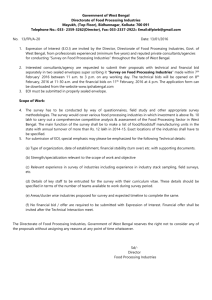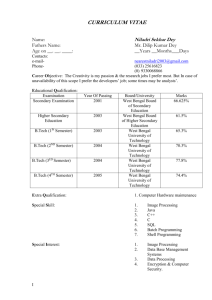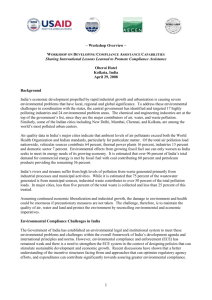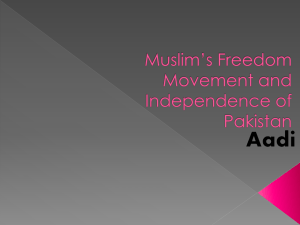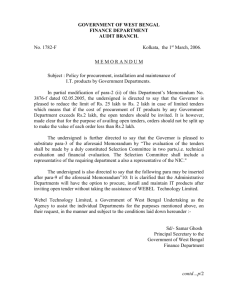Precious Stone - Welcome to BSIT (Evening) web site
advertisement
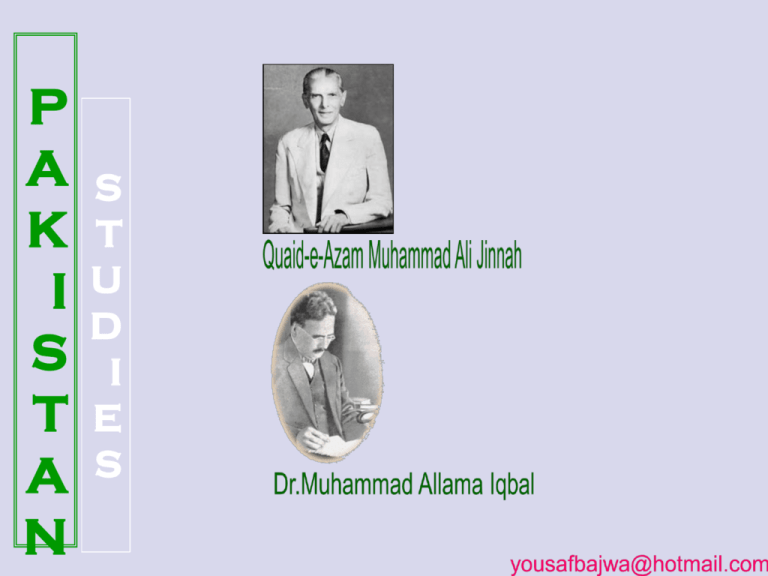
P A K I S T A N S T U D I E S Independence Struggle - The Congress attempted to include the Muslim community in the independence struggle. some Muslims were very active in the Congress the majority of Muslim leaders did not trust the party, viewing it as a “Hindu-dominated" organization. Independence Struggle Some Muslims felt that there was a need to address the issue of the Muslim identity within India. Thus in 1877, Syed Amer Ali formed the Central National Muhammadan Association to work towards the political advancement of the Muslims, but the organization declined towards the end of the nineteenth century. Independence Struggle A turning point came in 1900 British administration in the United Provinces (Now Uttar Pradesh) made Hindi, written in the Devanagari script, the official language. The Muslims feared and the AllIndia Muslim League was founded on December 30th, 1906, on the sidelines of the annual All India Muhammadan Educational Conference in Shahbagh, Dhaka. Independence Struggle The meeting was attended by three thousand delegates and presided over by Nawab Viqar-ul-Mulk. It addressed the issue of legitimate safeguards for Muslims and finalised a programme. A resolution, moved by Nawab Salimullah and seconded by Hakim Ajmal Khan. Nawab Viqar-ul-Milk, declared: Independence Struggle The musalmans are only a fifth in number as compared with the total population of the country, it is manifest that if at any remote period the British government ceases to exist in India, then the rule of India would pass into the hands of that community which is nearly four times as large as ourselves …our life, our property, our honour, and our faith will all be in great danger, when even now that a powerful British administration is protecting its subjects, we the Musalmans have to face most serious difficulties in safe-guarding our interests from the grasping hands of our neighbors. Independence Struggle The constitution and principles of the League were contained in the "Green Book", written by Maulana Mohammad Ali . Its goals at this stage did not include establishing an independent Muslim state, but rather concentrated on protecting Muslim liberties and rights, promoting understanding between the Muslim community and other Indians, educating the Muslim and Indian community at large on the actions of the government, and discouraging violence. Independence Struggle However, Jinnah did not join the League until 1913, Even at this stage, Jinnah believed in Muslim-Hindu cooperation to achieve an independent, united India, The League gradually became the leading representative body of Indian Muslims. Jinnah became its president in 1916. Independence Struggle Meaning & History of Urdu language: Turkish Word, means ARMY (LASHKAR) Started when Muslims conqueror South Asia. Now the Urdu is a developed language. British started finishing the Language of Urdu Muslims also adopt Persian language. Independence Struggle Urdu Hindi Conflict During the stay of Sir S.A.K a great leader 19th Centaury, in Banaras Hindu demanded the British that the Deonagri script of Hindi should be official Language along with English Muslims opposed it and great tension & conflict raised. Independence Struggle Sir Syed & Urdu language - S. Syed efforts for the education of Muslims made Aligarh his centre and laid the foundation for MAOS - 1877 this school became a college - Weekly gazette of Urdu & English was published - Translated many English books into Urdu for Muslims - made efforts form the plate form of Mohammadan Educational Conference which proved successful. Independence Struggle British & Hindus steps for element ion Urdu In 1871 the lieutenant Governor of Bengal Province George Campbell declared Hindi as the courts language. Also start using in offices Later on in 1900 the Governor of U.P Antony Mac Donald gave permission for the use of Deonagri Script of Hind and Hindi language in the courts. 1937 the congress ministries also took many steps for the implementation of Hindi in all provinces Independence Struggle Separate & Combined Electorate Separate Electorate; Rights & interests of different nations are protected by fixing their seats according to the ratio of their population. Combined Electorate; Rights & interests of different nations are not protected by allotting separate seats rather the candidates from any nation can contest for one seat and can win by majority of his nation. Independence Struggle Efforts of Sir Syed for Separate Electorate Hindu majority could dominate the Muslims Minority by combined electorate. Sir Syed opposed it first time Addressing the Muslims of Meerut on 16.01.1888 “This thing is confirmed that the population of Hindus is four times more. We can calculate that the Hindu candidate will get four votes & Muslim candidate will get only one vote. It is necessary that separate electorate will be implemented & Hindu Muslims constituencies be marked so that Hindu votes will elect Hindu candidate & Muslim voters will elect Muslim candidates”. Independence Struggle Act of 1892 & Combined Electorate • The combined electorate were implemented for the first time in central & provincial councils • Terms were given property, income & Edu • The majority of Muslims could not fulfil these terms Independence Struggle The Muslims reaction of Combined Electorate • Sir Syed Ahmad khan strongly criticized the electoral conations. His son Syed Mahmood & Principal of Ali Garh College Mr.. Beck sent a memorandum to the British Govt demanding that; “Due to combined electorate Muslims would always remain deprived of leadership. Besides Muslims are a separate nation therefore separate electorate should be implemented” Division of Bengal Division of Bengal October 16, 1905 It was in Bengal that the British has first established themselves, & built their own capital city, Calcutta, which led the rest of India in adopting western education, manners & fashions. Division of Bengal Division of Bengal October 16, 1905 Bengal was a large, thickly populated area and Calcutta has to administer not only British India but the Bengal Presidency itself. Lord Curzon, for reasons of facilitating administration, divided Bengal into two parts, West & East. To East Bengal was added Assam. Both parts of Bengal under the British rule, the creation of the east led to sharp Hindu protest. Division of Bengal Reasons for Division of Bengal The Area was one lac eighty nine thousand square mile, whereas the population consisted of seven crore eighty lacs The Indian majority side of the Bengal province was developed East Bengal was the Muslim majority area. They were facing Administration, discipline, infrastructure etc. Division of Bengal Reasons for Division of Bengal There was a sea port in West Bengal in Calcutta so no thought was given to improve & develop the seaport in East Bengal at Chittagong. Division was necessary for its destruction. Large scale production of Jute in East Bengal, no development was there and local industries have collapsed. Division of Bengal Events of division of Bengal In 1904, the viceroy of India Lord Curzon visited the both wings of Bengal He saw the problems of these areas and sent a report to Britain Suggestion was to make East Bengal & Assam into new provinces The Secretary of State for India St. John Brodrich sanctioned it in June Bengal was divided into two parts on 16th October, 1905 For both the provinces separate lieutenant Governors, revenue board and legislative councils. Division of Bengal Demarcation of new provinces (East Bengal & Assam) The Area was 106540 square miles Total population was 31M, Muslims were 18M & Hindus 12 M Districts of Chittagong and Dhaka Divisions, Rajshahi Division excluding Darjeeling, and the District of Malda. Sea port was Chttagong Division of Bengal Demarcation of new provinces (West Bengal) Except the East Bengal & Assam all area was included in West Bengal Area of Orissa was also included in it The area was 140580 square miles Its population was 54 M, Muslims only 9M & Hindus 42 M Centre of the province was Calcutta Sea port was Calcutta Division of Bengal Benefits for Bengali Muslims Funds for the development of Bengal which were only used in West Bengal Now equally distributed and also spent on development of East Bengal Funds were to be spent on the improvement of infrastructure A separate building of High Court, Muslim newspapers were to be promoted Employment opportunity for the Muslims in the government, semi government sectors and non governmental organizations Developments programs for the Chittagong sea port Division of Bengal Reaction of Division of Bengal (By Muslims) Leader in East Bengal was Nawab Saleem ullah khan of Dhaka The Muslims group appreciated the decision of division of Bengal They laid a foundation named “Mohammadan provincial Union” Its aim to protect the political rights and interests of the Muslims Other Muslim community also supported the division of Bengal A letter of thanks was also sent to the Government Division of Bengal Division of Bengal Reaction of Division of Bengal (By Hindus) Hindus were not happy on the division of Bengal 16th October was observed as national protest day Influenced by the Chinese boycott of American goods Hindus started a SAUDESHI movement of this division (a devotee of one's own country) This movement boycotted British-made goods and encouraged the production and use of Indian-made goods to take their place Congress pressurized the British Manchester chamber of commerce for the protection and promotion of its trade, it should pressurize the Government Annulment of division of Bengal 12th December,1911 In 1910 George the 5th became the British King Lord Harding became the Viceroy of India On December 12, 1911 court was set in Delhi He made a number of announcements but one that was very important that is annulment of division of Bengal He also shift the capital from Calcutta to Delhi Annulment of division of Bengal 12th December,1911 Effects of Annulment Decision Start of Extremism in Politics Congress proved a Hindu political party Establishment of Dhaka University Independence Struggle The constitution and principles of the League were contained in the "Green Book", written by Maulana Mohammad Ali . Its goals at this stage did not include establishing an independent Muslim state, but rather concentrated on protecting Muslim liberties and rights, promoting understanding between the Muslim community and other Indians, educating the Muslim and Indian community at large on the actions of the government, and discouraging violence. Simla Deputation 1906 Lord Minto was appointed as the Viceroy on India in 1905 the Muslim leaders drew up a plan for separate electorates for their community They presented it to the Viceroy Lord Minto at Simla, on October 1, 1906. Young Aga khan read the address, Mr. Bilgrami wrote the text of the plan The Simla Deputation consisted of 35 members, headed by Sir Aga Khan Simla Deputation 1906 Demands of the Delegations Separate Electorate Demands for more seats than population Share in the Government Services Membership of judges & executive councils Representation in the senate & syndicate of the Universities Making of the Muslim Universities Simla Deputation 1906 Viceroy’s answer to the delegation “I am aware of the injustices and aggression inflicted upon the Muslim and I am also trying to compensate them. I will definitely take these demands to the committee which will come to India to implement constitutional reforms and will compile the recommendations” Simla Deputation 1906 The Simla Deputation was successful because the Muslims were strongly urged to protect their separate identity, whereas the British responded to their demands, as Lord Minto was anxious to pull them out of their political discontent. Simla Deputation 1906 Separate electorates were given statutory recognition in the Indian Councils Act of 1909. Muslims were accorded not only the right to elect their representatives by separate electorates, but also the right to vote in general constituencies. In addition, they were also given Weightage in representation.
